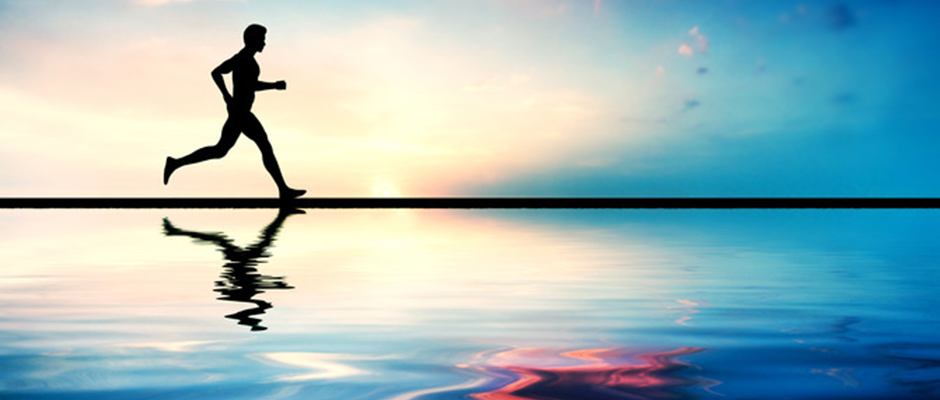If you’ve ever been a runner, you’ll have heard it a million times: running will cause knee pain! Friends, family, the media, and even your doctor will tell you this over and over. While it is true that some runners suffer from knee pain, the fact is that running itself does not cause knee pain. What causes knee pain has more to do with the way you run or the shoes you wear. Walkers can have knee pain as well for the same reasons. Many blame knee pain on the pounding of the knees, and that is exactly what I want to address in this edition.
What Can Cause Knee Pain
Knee pain has many sources, the least of which is your knee. Yes, over time, without doing the precautionary things to prevent knee damage, injuries can occur. But, if you understand how the joint works with the muscles, the damage can be minimized. Let’s begin with the way you run. For some people, the condition of their feet will determine how they run. Your feet should be as soft as the palms of your hands unless your hands are hard too…I’ll save that for another article. Anyway, learning how to massage your feet, top and bottom, will prevent things like soreness in your arches, heels, and the balls of your feet. Most of us try to solve this with shoes and, for the short term, shoes can help, but long term can lead to more severe damage. The arch of the foot serves as a spring in your step. If the arch is soft and pliable, it can absorb the impact when your foot hits the ground. This is true for walking as well.
When people run or walk, they should push off with their toes. This does not mean running on the balls of your feet. That is a surefire way to get plantar fasciitis or Achilles tendinitis. To push off with the toes, the arch needs to be flexible. The ankles must flexible as well, and that is where calf stretches play a huge role. If you stretch your calves by dropping your heels off a step or curb, using a slant board at the gym, or leaning against a wall, let me be the first to tell you that you have never properly stretched your calves, and yes, THAT can cause knee pain! Check out some of my past posts to view the videos for effective calf stretching.
When your feet and ankles are not flexible, strain is put on the shin muscles, which can cause knee pain on the front side. The shin is strained because most of your body weight is felt in the shins, and they are not designed for that. This can also lead to shin splints. If you are a heel striker, the pounding is hard on the knee and hip joints and your back. Heel striking is due to heel padding in your shoes. Watch a woman walking in high heels. The first thing she does is drive the heel into the ground and then drop her toes. Heel padding does the same thing to a lesser degree.
How to Massage and Soften Your Feet
To soften the arches of your feet, simply sit in a chair, place one foot on the knee of the opposite leg and use your thumb to press spots on your foot. The mistake people make here is to rub the foot or buy a super hard gadget, thinking they will force out the hardness, not realizing they are creating more hardness because they are fighting with their brain. Take your time and feel for sore spots. When you find a sore spot, simply press hard enough to feel, breathe out, and allow the muscle to relax. If you press too hard, you cannot breathe and therefore the muscle cannot let go. We have been taught to manhandle our muscles, and that is in direct conflict with our brain. Too much pain! Work all over the arches of both feet every morning and evening to prevent them from hardening.
Foot Metatarsal Extension and Flexion
The top of the foot is equally important. Every time you take a step, the foot needs to be soft enough to widen, which will improve your balance. It is more difficult to balance on narrow feet. Part of the problem people have with balance is they have worn shoes that are too narrow and their feet have been molded to the shoes. No, you were not born that way; this happens because we put shoes on babies as soon as they are born. That is why!
Using your fingers, rub between the bones on the top of your foot, beginning at the toes and moving up towards the ankle. Do that a couple of times each time you massage your feet. Be sure to stretch your toes back towards you and then down away from you. Inflexible feet and calves create more knee and back pain than anything else in your body. Believe it or not, the inflexible calves and feet can even cause neck and shoulder pain.
Foot Pronation and Supination
How to Stretch
The two videos seen above demonstrate proper foot-stretching techniques. And if you look back to some of my previous posts, you can find the calf stretch videos. If you are a runner or walker, I recommend you do these stretches at least every morning and evening for the rest of your life. Effective foot and calf stretching only takes about 10 minutes and will prevent most injuries suffered by runners and walkers.
You can learn more at The Muscle Repair Shop Videos on YouTube..
Want to Talk with Me Directly? Start Here
We’re happy to offer you a complimentary 30-min virtual consultation so you can experience this for yourself. Schedule your introduction to Stretch n Release now.
About The Muscle Repair Shop
Drawing upon his personal experience as a former competitive athlete turned wheelchair, obese, and chronic pain sufferer, Muscle Repair Shop Founder Butch Phelps decided to take his health into his own hands when at the age of 36 he was told he might not make it to his 40th birthday. Applying balanced nutrition advice from his doctor along with a sound exercise program, he went from 315 lbs. to 180 lbs. Motivated by his experience, he then acquired degrees in advanced therapeutic massage and aging sciences to help people eliminate chronic pain. This included applying his expertise in how people age, including the effects of dementia, anatomy, psychology, and the day-to-day struggles living as an older person to his practice and development of The Muscle Repair Shop’s one-of-a-kind Stretch n’ Release Technique.
Available through in-office and virtual coaching treatment sessions, this unique combination of stretching and breath work teaches the brain to release the emotional side of muscle tension and pain allows clients to find lasting relief and healing from stiffness, aches, injuries, and chronic pain. The at-home exercises come with customized instructional videos and virtual or in-office support, allowing clients to enjoy and experience life and sports as they did before limitations slowed or curtailed activities.


